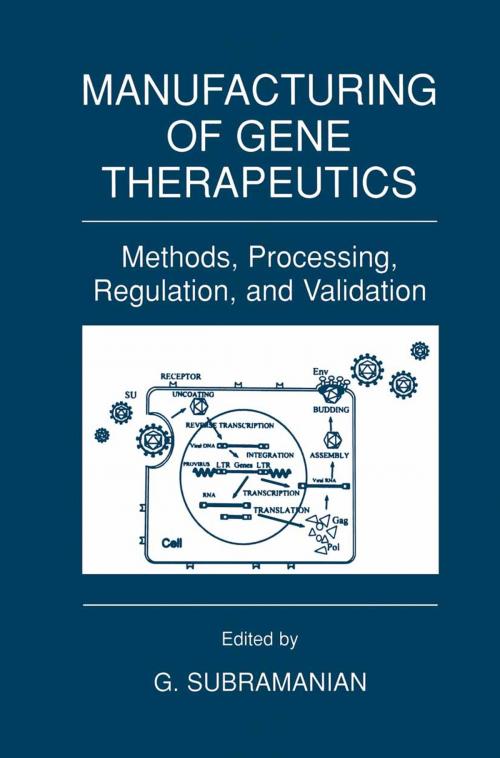Manufacturing of Gene Therapeutics
Methods, Processing, Regulation, and Validation
Nonfiction, Science & Nature, Science, Chemistry, Clinical, Health & Well Being, Medical, Specialties, Pharmacy| Author: | ISBN: | 9781461513537 | |
| Publisher: | Springer US | Publication: | December 6, 2012 |
| Imprint: | Springer | Language: | English |
| Author: | |
| ISBN: | 9781461513537 |
| Publisher: | Springer US |
| Publication: | December 6, 2012 |
| Imprint: | Springer |
| Language: | English |
Advances in molecular biology and recombinant DNA technology have accelerated progress in many fields of life science research, including gene therapy. A large number of genetic engineering approaches and methods are readily available for gene cloning and therapeutic vector construction. Significant progress is being made in genomic, DNA sequencing, gene expression, gene delivery and cloning. Thus gene therapy has already shown that it holds great promise for the treatment of many diseases and disorders. In general it involves the delivery of recombinant genes or transgenes into somatic cells to replace proteins with a genetic defect or to transfer with the pathological process of an illness. The viral and non-viral delivery systems may hold the potential for future non-invasive, cost-effective oral therapy of genetically-based disorders.
Recent years have seen considerable progress in the discovery and early clinical development of a variety of gene therapeutic products. The availability, validation, and implementation of gene therapeutic products has also enabled success in testing and evaluation. New challenges will need to be overcome to ensure that products will also be successful in later clinical development and ultimately for marketing authorisation. These new challenges will include improvements in delivery systems, better control of in-vivo targeting, increased level transduction and duration of expression of the gene, and manufacturing process efficiencies that enable reduction in production costs. Perhaps profound understanding of regulated gene design may result in innovative bioproducts exhibiting safety and efficacy profiles that are significantly superior to those achieved by the use of naturally occurring genes. This procedure may contribute considerably to fulfilling standards set by regulatory authorities.
This book provides an overview of the current advances in the field of gene therapy and the methods that are being successfully applied in the manufacture of gene therapeutic products, and hopefully will stimulate further progress and advancement in this field to meet the ever-increasing demands.
Advances in molecular biology and recombinant DNA technology have accelerated progress in many fields of life science research, including gene therapy. A large number of genetic engineering approaches and methods are readily available for gene cloning and therapeutic vector construction. Significant progress is being made in genomic, DNA sequencing, gene expression, gene delivery and cloning. Thus gene therapy has already shown that it holds great promise for the treatment of many diseases and disorders. In general it involves the delivery of recombinant genes or transgenes into somatic cells to replace proteins with a genetic defect or to transfer with the pathological process of an illness. The viral and non-viral delivery systems may hold the potential for future non-invasive, cost-effective oral therapy of genetically-based disorders.
Recent years have seen considerable progress in the discovery and early clinical development of a variety of gene therapeutic products. The availability, validation, and implementation of gene therapeutic products has also enabled success in testing and evaluation. New challenges will need to be overcome to ensure that products will also be successful in later clinical development and ultimately for marketing authorisation. These new challenges will include improvements in delivery systems, better control of in-vivo targeting, increased level transduction and duration of expression of the gene, and manufacturing process efficiencies that enable reduction in production costs. Perhaps profound understanding of regulated gene design may result in innovative bioproducts exhibiting safety and efficacy profiles that are significantly superior to those achieved by the use of naturally occurring genes. This procedure may contribute considerably to fulfilling standards set by regulatory authorities.
This book provides an overview of the current advances in the field of gene therapy and the methods that are being successfully applied in the manufacture of gene therapeutic products, and hopefully will stimulate further progress and advancement in this field to meet the ever-increasing demands.















